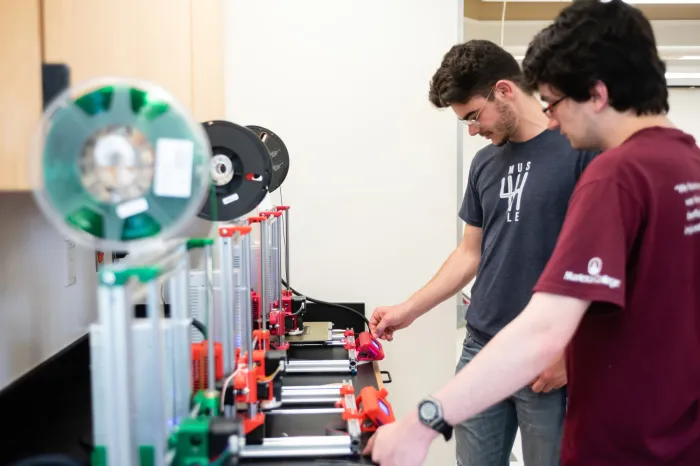
Marietta College first-year student Mitch Nelsen ’22 grew up around cars. He also worked with Legos as a kid, so building and tinkering is just something he’s always loved to do.
This semester, he’s been ‘tinkering’ with 3-D printing. It’s a course custom built for someone like him because students aren’t just learning about 3-D printing, they are building the printers first.
“I’m planning on restoring a (Mazda) RX7 and parts are very hard to find, especially 1980s models,” Nelsen says. “I like the idea of being able to make the parts instead of scouring the Internet or having to order parts from Japan. The parts haven’t been in production for 30 years.”
That practical application of 3-D printing is exactly the point of offering the 3-D, DIY option, says Dr. Craig Howald, who implemented the first-time course. More than a dozen students of all ages and disciplines signed on to build, design and print 3-D projects. It serves as an elective in Marietta College’s Entrepreneurship program.
“The principle idea is that someone can make anything they need/want, and empowering them to do that,” the physics professor says.
“You do not need an industrial plant or a huge design team in order to make actual things,” Howald says. “The actual machines used are not so important, they only fill three subservient goals: to have something to execute personal design ideas with, to gain experience putting mechanical and electrical things together, and to show that small, inexpensive machines can do a lot.”
Room 105 in the Rickey Science Center has been temporarily transformed into a maker space. There, 3-D printers in various forms of construction line the workspaces, many topped with colorful spools of fused filament, which the printers “melt” down into product that’s extruded for the printing of objects.
In addition to building the printers, Howald says students are learning software that will enable them to print original designs.
“We are subject to physical limitations but creative limitations can hold you back even more,” he says. “If you have an idea, there are technologies to make it.”
Nelsen, an Applied Physics major with a graphic design minor, hasn’t yet printed any of his own designs, but he’s used free images available online.
“I printed out a shift knob and it’s completely useable,” Nelsen says. “I mailed it to my little brother and he’s using it on his first car.”
Nelsen hopes to find a job in automotive design.
Students in the class will have the option of keeping the 3-D printer they built, or leaving their printer with the College for future students to use.
Will Nelsen be keeping his?
“Heck ya — absolutely,” he says.